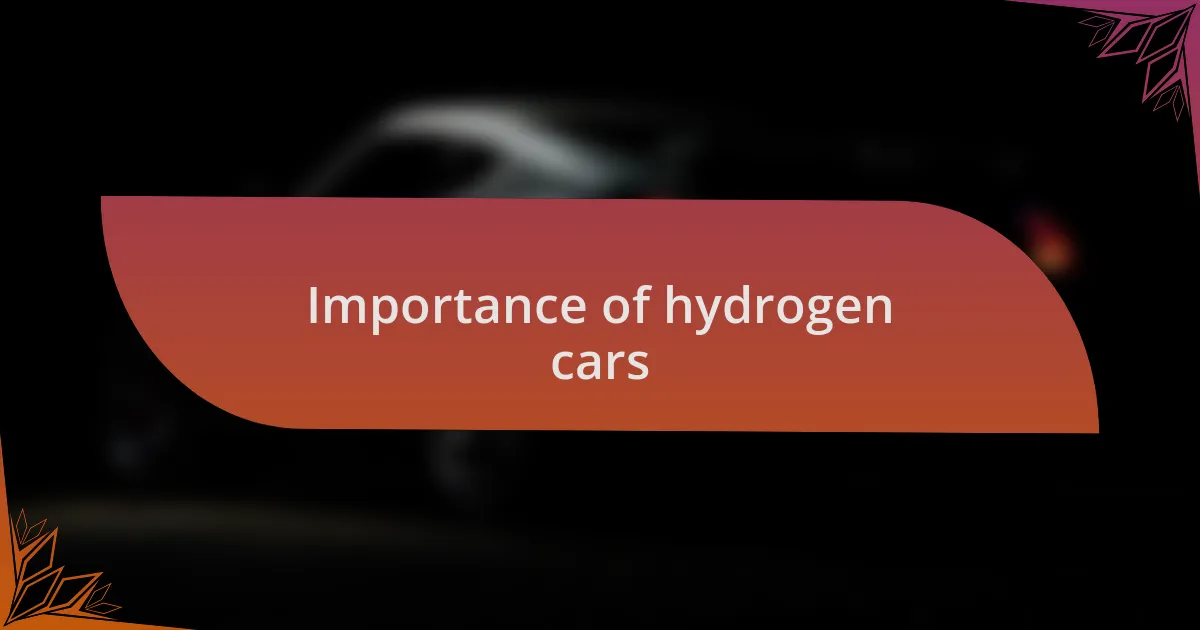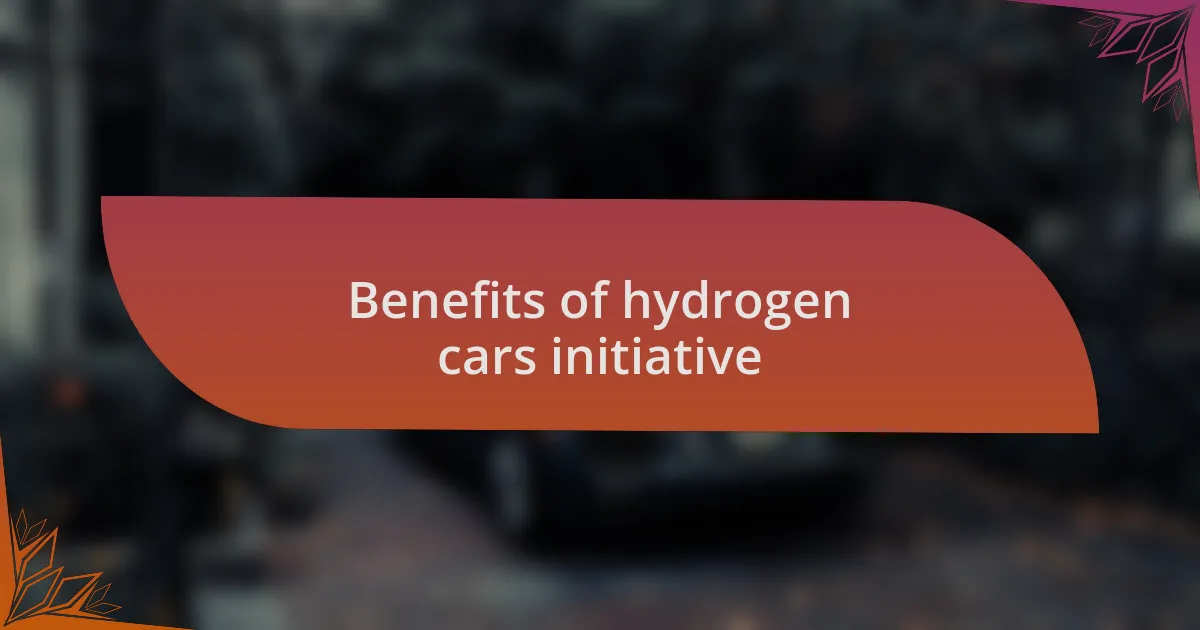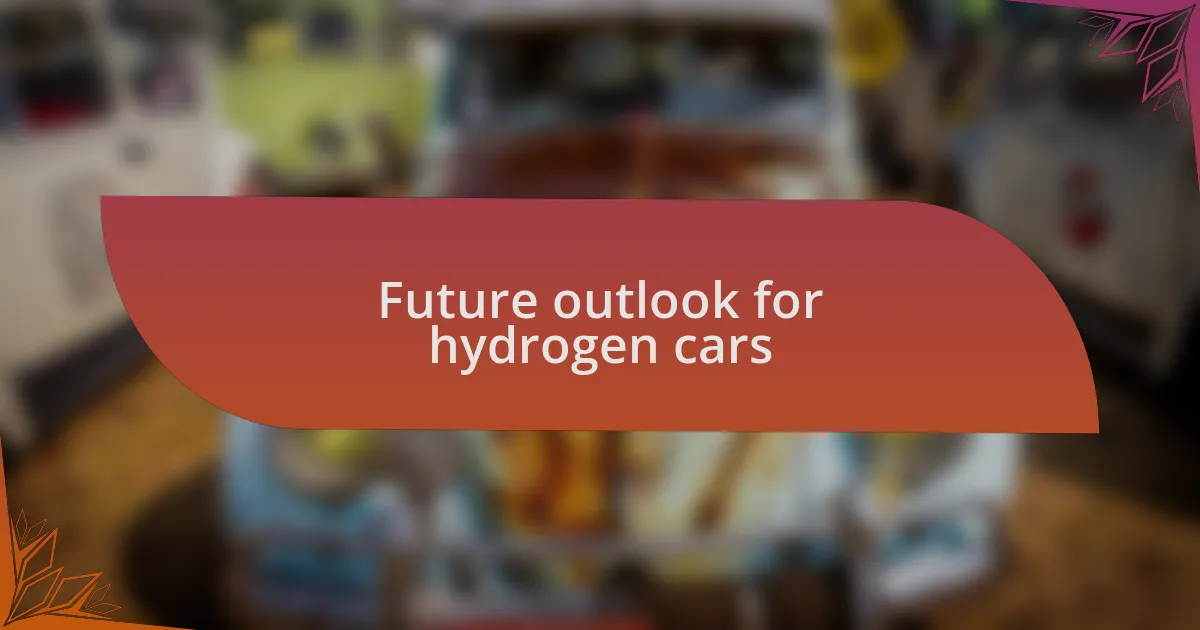Key takeaways:
- Public-private partnerships (PPPs) enhance infrastructure development, exemplified by collaborations in hydrogen fuel initiatives that foster innovation and shared resources.
- Hydrogen cars offer significant environmental benefits and economic opportunities, with the potential for cleaner air and job creation through investment in renewable energy technologies.
- Successful case studies, such as Germany’s “H2 Mobility” and California’s partnerships, demonstrate the effectiveness of collaboration in advancing hydrogen vehicle adoption.
- The future of hydrogen cars looks promising, with advances in technology and infrastructure potentially leading to widespread adoption and reduced carbon footprints.

Public private partnerships defined
Public-private partnerships, often abbreviated as PPPs, are collaborative agreements between government entities and private sector companies. These partnerships leverage the strengths of both sectors: the government’s ability to regulate and fund initiatives, and the private sector’s efficiency and innovation. I’ve often wondered how these partnerships can help bridge gaps in infrastructure and services, especially in areas like renewable energy.
In my experience, effective PPPs can dramatically enhance project outcomes. For instance, when local governments partner with private firms to develop hydrogen fuel stations, they can pool resources to create infrastructure that might otherwise be cost-prohibitive. Isn’t it fascinating how such partnerships can lead to transformative changes and make greener transportation more accessible for everyone?
Moreover, these collaborations often lead to shared risk and reward. The private sector typically brings technical expertise and financial backing, while the public sector ensures that community needs are met. Reflecting on past projects, I realize that successful PPPs foster a sense of trust and commitment between parties, driving innovation that can have lasting benefits for society.

Importance of hydrogen cars
The significance of hydrogen cars cannot be overstated in our quest for sustainable transportation. I’ve often felt a sense of hope when seeing hydrogen-powered vehicles gliding quietly by; they symbolize a future where our reliance on fossil fuels diminishes. With zero tailpipe emissions, hydrogen cars contribute to cleaner air and a healthier environment, aligning perfectly with our collective responsibility to combat climate change.
One personal experience that stands out for me occurred during a visit to a hydrogen fuel station. Watching a driver refuel their car in just a few minutes, much like they would at a conventional gas station, made me realize the potential of hydrogen technology. It’s fascinating to think about how these vehicles not only match the convenience of traditional cars but also help us shift toward renewable energy sources. This blend of innovation and practicality opens the door to a viable alternative for millions looking for planet-friendly options.
Moreover, as we increasingly invest in hydrogen infrastructure, the broader implications unfold. Imagine the ripple effect: job creation, energy independence, and reduced greenhouse gases. Reflecting on these possibilities, I can’t help but wonder—what if hydrogen cars become the norm? The transformation could redefine our cities, leading to a more sustainable future for generations to come.

Benefits of hydrogen cars initiative
Hydrogen cars present a multitude of benefits that extend beyond just environmental impact. For instance, when I first learned about the potential for hydrogen fuel to be produced from renewable sources, I felt a spark of excitement. The idea that we could harness solar or wind energy to create the very fuel that powers our vehicles truly captivated me. This process not only reduces our carbon footprint but also supports energy diversification, providing a more resilient energy landscape.
Another striking advantage of the hydrogen cars initiative is the economic opportunity it brings. Reflecting on a recent discussion with industry experts, I realized how this shift could invigorate local economies. By prioritizing hydrogen technology, we can create countless jobs in research, manufacturing, and infrastructure development. Isn’t it inspiring to think about the potential for communities to thrive through sustainable innovation?
Lastly, the safety profile of hydrogen vehicles adds another layer of benefit. One day, I was at a green technology fair, and a curious child asked me if hydrogen is dangerous. I explained that, while hydrogen is flammable, it’s actually managed safely in vehicles thanks to advanced engineering. This conversation resonated with me, as it highlighted how educating people about hydrogen’s safety can demystify it and foster greater acceptance. The initiative not only promotes cleaner air but also empowers us through informed choices about the future of mobility.

Role of public private partnerships
Public-private partnerships (PPPs) play a crucial role in the development of hydrogen car initiatives by seamlessly bridging the gap between government objectives and industry innovation. I remember attending a local government meeting where officials discussed funding opportunities for green technology projects. It struck me how essential it is for the public sector to work hand-in-hand with private companies to ensure that the right resources and expertise are available for advancing hydrogen fuel infrastructure.
These collaborations not only help in securing necessary investments but also foster an environment where knowledge and best practices can be shared. I recall feeling inspired when a leading automotive manufacturer shared their plans for hydrogen vehicles during a conference—it was evident that their progress relied heavily on supportive policies and streamlined regulations from the government. Can you imagine the potential impact when both entities unite their strengths?
Moreover, PPPs can accelerate research and development, paving the way for innovative solutions. During a project I worked on involving renewable energy, I witnessed firsthand how public funding can catalyze private research efforts. This synergy often leads to breakthroughs that neither party could achieve independently, ultimately propelling the hydrogen car initiative into the mainstream more quickly than we might expect. It’s exciting to think about what the future holds when these collaborations thrive!

Case studies of successful initiatives
One notable case is the collaboration between Germany and several automotive manufacturers, including BMW and Daimler. They launched the “H2 Mobility” project, which aimed to establish a nationwide hydrogen refueling network. I remember reading about the ambitious plans for over 400 hydrogen stations across the country. It was fascinating to see how both the government and private sector pooled their resources and expertise to tackle the logistical challenges of such an extensive infrastructure.
In California, the partnership between state agencies and companies like Toyota and Honda has significantly advanced hydrogen vehicle adoption. I was struck by a presentation showcasing how these partnerships facilitated pilot programs to test hydrogen vehicles in real-world conditions. This hands-on approach truly exemplifies how public-private partnerships can bring together diverse stakeholders to generate valuable insights and accelerate technological deployment.
Additionally, the collaboration in South Korea between the government and private corporations has led to the development of the world’s first commercial hydrogen-powered buses. When I learned about the enthusiastic response from communities embracing cleaner transportation options, it made me reflect on how vital it is to align public interests with private innovation. Isn’t it exhilarating to see such local commitments driving the hydrogen revolution forward?

My personal views on collaboration
Collaboration, in my view, is the heartbeat of any successful initiative. I’ve witnessed firsthand how bringing together diverse perspectives can lead to innovative solutions that no single entity could achieve alone. For instance, during a community workshop I attended, people from different backgrounds shared their insights on hydrogen technology, and it was incredible to see how these exchanges sparked ideas that reshaped our understanding of potential applications.
I believe that when public and private sectors align their goals, the impact can be transformative. I recall a project where our local university partnered with a renewable energy company, aiming to develop educational programs around hydrogen fuel. The palpable excitement among students and faculty not only enhanced the quality of learning but also created a dynamic environment for future innovations. Isn’t it amazing how collaboration can energize a community and propel an initiative forward?
Moreover, I’ve come to realize that effective collaboration requires openness and trust among stakeholders. I remember discussing with a colleague about a failed project due to miscommunication between partners. That experience taught me the value of building strong relationships and a shared vision from the outset. How can we expect meaningful progress without these foundational elements in our partnerships?

Future outlook for hydrogen cars
The future outlook for hydrogen cars is undeniably bright, and I find it exhilarating to think about the potential advancements on the horizon. Just the other day, I was chatting with a friend who’s deeply invested in renewable energy. We discussed how ongoing investments in hydrogen infrastructure could dramatically increase accessibility for both consumers and manufacturers. This shift not only paves the way for cleaner transportation but also invites more players into the market, invigorating competition and innovation. Isn’t it exciting to envision a landscape where hydrogen truly becomes a mainstream option?
As I reflect on my experiences attending various automotive expos, I’ve observed a palpable shift in industry sentiment towards hydrogen vehicles. The enthusiasm among engineers showcasing their prototypes was infectious, and I could sense a turning tide. They spoke passionately about breakthroughs in fuel cell technology and how these innovations could lead to faster refueling times and improved efficiency. When I hear these conversations, it leaves me wondering: how soon will we start seeing hydrogen cars on every street corner?
It’s also fascinating to consider the environmental implications of widespread hydrogen car adoption. While discussing this topic with a sustainability expert recently, we pondered the significant reduction in carbon footprints that could be realized if nations fully embraced hydrogen technology. This isn’t just about cleaner air; it’s about transforming cities and saving lives. If we harness this opportunity correctly, the benefits could ripple through generations. What kind of legacy do we want to leave for future drivers?